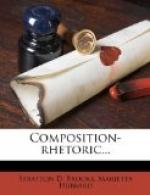+191. Argument from Example.+—It has been pointed out in the study of inductive reasoning (Section 176) that a single example may suffice to establish a general notion of a class. In dealing with objects of the physical world, if essential and invariable qualities of the object are considered, they may be asserted to be qualities of each member of the class, and such an argument from an individual to all the members of the class is convincing. They thus rank with arguments from sign as effective in proving the certainty of a proposition.
In dealing with human actions, on the other hand, examples are seldom proofs of fact. We cannot say that all men will act in a certain way under given circumstances because one man has so acted. Nevertheless, arguments by examples are frequently used and are especially powerful when we wish not only to convince a man, but also to persuade him to action. This persuasion to action must be based on conviction, and in such a case the argument from sign that convinces the man of the truth of a proposition should precede the example that urges him to action. After convincing a friend that there are advantages to be derived from joining a society, we may persuade him to join by naming those who have joined.
+192. Argument from Analogy.+—Analogy is very much relied upon in practical life. Reasoning from analogy depends upon the recognition of similarity in regard to some particulars followed by the inference that the similarity extends to other particulars. As soon as it was known that the atmospheric conditions of the planet Mars are similar to those of the earth, it was argued by analogy that Mars must also, be inhabited.
An analogy is seldom conclusive and, though it is often effective in argument, it must not be taken as proof of fact. The mind very readily observes likenesses, and when directed toward the establishing of a proposition easily overlooks the differences. In order to determine the strength of an argument from analogy, attention should be given to the differences existing between the two propositions considered. False analogies are very common. We must guard against using them, and especially against allowing ourselves to be convinced by them. Even when the resemblance is so slight as to render analogy impossible, it may serve to produce a metaphor that often has the effect of argument.
It is much easier to captivate the fancy with a pretty or striking figure than to move the judgment with sound reason.... His (the speaker’s) picture appeals to the mind’s visible sense, hence his power over us, though his analogies are more apt to be false than true....
The use of metaphor, comparison, analogy, is twofold—to enliven and to convince; to illustrate and enforce an accepted truth, and to press home and clinch one in dispute. An apt figure may put a new face upon an old and much worn truism, and a vital analogy may reach and move the reason. Thus when Renan, referring to the decay of the old religious beliefs, says that the people are no poorer for being robbed of false bank notes and bogus shares, his comparison has a logical validity....




